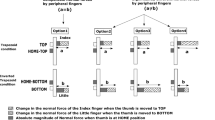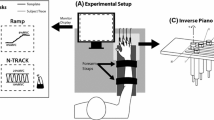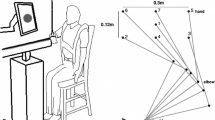Abstract
We address issues of simultaneous control of the grasping force and the total moment of forces applied to a handheld object during its manipulation. Six young healthy male subjects grasped an instrumented handle and performed its cyclic motion in the vertical direction. The handle allowed for setting different clockwise (negative) or counterclockwise torques. Three movement frequencies: 1, 1.5 and 2 Hz, and five different torques: –1/3, –1/6, 0, 1/6 and 1/3 Nm, were used. The rotational equilibrium was maintained by two means: (1) Concerted changes of the moments produced by the normal and tangential forces, specifically anti-phase changes of the moments during the tasks with zero external torque and in-phase changes during the non-zero-torque tasks, and (2) Redistribution of the normal forces among individual fingers such that the agonist fingers—the fingers that resist external torque—increased the force in phase with the acceleration, while the forces of the antagonist fingers—those that assist the external torque—especially, the fingers with the large moment arms, the index and little fingers, stayed unchanged. The observed effects agree with the principle of superposition—according to which some complex actions, for example, prehension, can be decomposed into elemental actions controlled independently—and the mechanical advantage hypothesis according to which in moment production the fingers are activated in proportion to their moment arms with respect to the axis of rotation. We would like to emphasize the linearity of the observed relations, which was not prescribed by the task mechanics and seems to be produced by specific neural control mechanisms.












Similar content being viewed by others
References
Arimoto S, Tahara K, Yamaguchi M, Nguyen PTA, Han HY (2001) Principles of superposition for controlling pich motions by means of robot fingers with soft tips. Robotica 19:21–28
Augurelle A-S, Penta M, White O, Thonnard J-L (2003) The effects of a change in gravity on the dynamics of prehension. Exp Brain Res 148:533–540
Burstedt MK, Flanagan JR, Johansson RS (1999) Control of grasp stability in humans under different frictional conditions during multidigit manipulation. J Neurophysiol 82:2393–2405
Cadoret G, Smith AM (1996) Friction, not texture, dictates grip forces used during object manipulation. J Neurophysiol 75:1963–1969
Cattaneo L, Voss M, Brochier T, Prabhu G, Wolpert DM, Lemon RN (2005) A cortico-cortical mechanism mediating object-driven grasp in humans. Proc Natl Acad Sci USA 102:898–903
Cole KJ, Abbs JH (1988) Grip force adjustments evoked by load force perturbations of a grasped object. J Neurophysiol 60:1513–1522
Cole KJ, Johansson RS (1993) Friction at the digit-object interface scales the sensorimotor transformation for grip responses to pulling loads. Exp Brain Res 95:523–532
Eliasson AC, Forssberg H, Ikuta K, Apel I, Westling G, Johansson R (1995) Development of human precision grip. V. Anticipatory and triggered grip actions during sudden loading. Exp Brain Res 106:425–433
Feldman AG (1966) Functional tuning of nervous system with control of movement or maintenance of a steady posture. 2. Controllable parameters of the muscles. Biophysics 11:565–578
Feldman AG (1986) Once more on the equilibrium-point hypothesis (lambda model) for motor control. J Motor Behav 18:17–54
Feldman AG, Latash ML (2005) Testing hypotheses and the advancement of science: recent attempts to falsify the equilibrium point hypothesis. Exp Brain Res 161:91–103
Flanagan JR, Tresilian JR (1994) Grip-load force coupling: a general control strategy for transporting objects. J Exp Psychol Hum Percept Perform 20:944–957
Flanagan JR, Wing AM (1993) Modulation of grip force with load force during point-to-point arm movements. Exp Brain Res 95:131–143
Flanagan JR, Wing AM (1995) The stability of precision grip forces during cyclic arm movements with a hand-held load. Exp Brain Res 105:455–464
Flanagan JR, Wing AM (1997) The role of internal models in motion planning and control: evidence from grip force adjustments during movements of hand-held loads. J Neurosci 17:1519–1528
Flanagan JR, King S, Wolpert DM, Johansson RS (2001) Sensorimotor prediction and memory in object manipulation. Can J Exp Psychol 55:87–95
Gao F (2002) Coordination of multi-finger prehension. Master’s thesis. The Pennsylvania State University, University Park
Gao F, Latash ML, Zatsiorsky VM (2005) Internal forces during object manipulation. Exp Brain Res 165(1):69–83
Gottlieb GL, Song Q, Hong DA, Almeida GL, Corcos D (1996) Coordinating movement at two joints: a principle of linear covariance. J Neurophysiol 75:1760–1764
Gysin P, Kaminski TR, Gordon AM (2003) Coordination of fingertip forces in object transport during locomotion. Exp Brain Res 149:371–379
Hermsdorfer J, Marquardt C, Philipp J, Zierdt A, Nowak D, Glasauer S, Mai N (1999) Grip forces exerted against stationary held objects during gravity changes. Exp Brain Res 126:205–214
Hogan N (1985) The mechanics of multi-joint posture and movement control. Biol Cybern 52:315–331
Hogan N, Flash T (1987) Moving gracefully: quantitative theories of motor coordination. Trends Neurosci 10:170–174
Imamizu H, Miyauchi S, Tamada T, Sasaki Y, Takino R, Putz B, Yoshioka T, Kawato M (2000) Human cerebellar activity reflecting an acquired internal model of a new tool. Nature 403:192–195
Imamizu H, Kuroda T, Yoshioka T, Kawato M (2004) Functional magnetic resonance imaging examination of two modular architectures for switching multiple internal models. J Neurosci 24:1173–1181
Johansson RS, Westling G (1984) Roles of glabrous skin receptors and sensorimotor memory in automatic control of precision grip when lifting rougher or more slippery objects. Exp Brain Res 56:550–564
Johansson RS, Backlin JL, Burstedt MK (1999) Control of grasp stability during pronation and supination movements. Exp Brain Res 128:20–30
Kailath T (1980) Linear systems. Prentice Hall, Englewood Cliffs, NJ
Kawato M, Kuroda T, Imamizu H, Nakano E, Miyauchi S, Yoshioka T (2003) Internal forward models in the cerebellum: fMRI study on grip force and load force coupling. Prog Brain Res 142:171–188
Kerr J, Roth B (1986) Analysis of multifingered hands. Int J Robot Res 4:3–17
Kinoshita H, Kawai S, Ikuta K, Teraoka T (1996) Individual finger forces acting on a grasped object during shaking actions. Ergonomics 39:243–256
Kinoshita H, Backstrom L, Flanagan JR, Johansson RS (1997) Tangential torque effects on the control of grip forces when holding objects with a precision grip. J Neurophysiol 78:1619–1630
Kording KP, Ku SP, Wolpert DM (2004) Bayesian integration in force estimation. J Neurophysiol 92:3161–3165
Lemay MA, Grill WM (2004) Modularity of motor output evoked by intraspinal microstimulation in cats. J Neurophysiol 91:502–514
Mason MT, Salisbury JK (1985) Robot Hands and the Mechanics of Manipulation. MIT Press, Cambridge, MA
McIntyre J, Berthoz A, Lacquaniti F (1998) Reference frames and internal models for visuo-manual coordination: what can we learn from microgravity experiments? Brain Res Rev 28:143–154
Murray RM, Li Z, Sastry SS (1994) A mathematical introduction to robotic manipulation. CRC Press, Boca Raton, FL
Mussa-Ivaldi F, Giszter S, Bizzi E (1994) Linear combinations of primitives in vertebrate motor control. Proc Natl Acad Sci USA 91:7534–7538
Nichols TR (2002) Musculoskeletal mechanics: a foundation of motor physiology. Adv Exp Med Biol 508:473–479
Nichols TR, Houk JC (1976) Improvement in linearity and regulation of stiffness that results from actions of stretch reflex. J Neurophysiol 39:119–142
Pataky TC, Latash ML, Zatsiorsky VM (2004a) Prehension synergies during nonvertical grasping, I: experimental observations. Biol Cybern 91:148–158
Pataky TC, Latash ML, Zatsiorsky VM (2004b) Prehension synergies during nonvertical grasping, II: Modeling and optimization. Biol Cybern 91:231–242
Prilutsky BI (2000) Coordination of two- and one-joint muscles: functional consequences and implications for motor control. Motor Control 4:1–44
Scholz JP, Latash ML (1998) A study of a bimanual synergy associated with holding an object. Hum Mov Sci 17:753–779
Serrien DJ, Kaluzny P, Wicki U, Wiesendanger M (1999) Grip force adjustments induced by predictable load perturbations during a manipulative task. Exp Brain Res 124:100–106
Shim J, Latash ML, Zatsiorsky V (2003) Prehension synergies: trial-to-trial variability and hierarchical organization of stable performance. Exp Brain Res 152:173–184
Shim JK, Latash ML, Zatsiorsky VM (2004a) Finger coordination during moment production on a mechanically fixed object. Exp Brain Res 157:457–467
Shim JK, Lay BS, Zatsiorsky VM, Latash ML (2004b) Age-related changes in finger coordination in static prehension tasks. J Appl Physiol 97:213–224
Shim JK, Latash ML, Zatsiorsky VM (2005) Prehension synergies in three dimensions. J Neurophysiol 93:766–776
Traub M, Rothwell J, Marsden C (1980) A grab reflex in the human hand. Brain 103:869–884
Winstein CJ, Abbs JH, Petashnick D (1991) Influences of object weight and instruction on grip force adjustments. Exp Brain Res 87:465–469
Wolpert D, Ghahramani Z, Jordan M (1995) An internal model for sensorimotor integration. Science 269:1880–1882
Yamamoto K, Kobayashi Y, Takemura A, Kawano K, Kawato M (2002) Computational studies on acquisition and adaptation of ocular following responses based on cerebellar synaptic plasticity. J Neurophysiol 87:1554–1571
Yoshikawa T, Nagai K (1991) Manipulating and grasping forces in manipulation by multifingered robot hands. IEEE Trans Rob Autom 7:67–77
Zatsiorsky VM (2002) Kinetics of Human Motion. Human Kinetics, Champaign, IL
Zatsiorsky VM, Gregory RW, Latash ML (2002a) Force and torque production in static multifinger prehension: biomechanics and control. I. Biomechanics. Biol Cybern 87:50–57
Zatsiorsky VM, Gregory RW, Latash ML (2002b) Force and torque production in static multifinger prehension: biomechanics and control. II. Control Biol Cybern 87:40–49
Zatsiorsky VM, Gao F, Latash ML (2003a) Finger force vectors in multi-finger prehension. J Biomech 36:1745–1749
Zatsiorsky V, Gao F, Latash ML (2003b) Prehension synergies: effects of object geometry and prescribed torques. Exp Brain Res 148:77–87
Zatsiorsky V, Latash ML (2004) Prehension synergies. Exerc Sport Sci Rev 32:75–80
Zatsiorsky VM, Latash M, Gao F, Shim JH (2004) The principle of superposition in human prehension. Robotica 22:231–234
Zatsiorsky V, Gao F, Latash ML (2005) Motor control goes beyond physics: differential effects of gravity and inertia on finger forces during manipulation of hand-held objects. Exp Brain Res 162:300–308
Acknowledgments
We thank anonymous reviewers for the valuable comments on the early version of the manuscript. This study was supported in part by NIH grants AR-048563, AG-018751 and NS-35032.
Author information
Authors and Affiliations
Corresponding author
Rights and permissions
About this article
Cite this article
Gao, F., Latash, M.L. & Zatsiorsky, V.M. Maintaining rotational equilibrium during object manipulation: linear behavior of a highly non-linear system. Exp Brain Res 169, 519–531 (2006). https://doi.org/10.1007/s00221-005-0166-z
Received:
Accepted:
Published:
Issue Date:
DOI: https://doi.org/10.1007/s00221-005-0166-z




